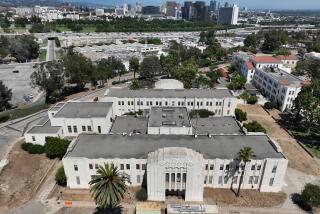Fight Ferments Over Plan to Spruce Up SDSU Gateways
- Share via
They want it to look like the entrance to Harvard University, to resemble the promenade at the University of Virginia, to echo the elegance of any university with a striking “front door.”
They want College Avenue to look like a real college drag, a la Telegraph Avenue at UC Berkeley or Westwood Boulevard at UCLA. They want more housing for students but also envision shops and stores and a real campus center.
They expect opposition.
They’re getting it now.
Plan to Change Image
“They” are a coalition spearheaded by the San Diego State University Foundation. Last fall, the foundation was asked by the university board of directors, including SDSU President Thomas B. Day, to develop a “master plan” that would alter a key part of university real estate for the purpose of changing the image of the school.
The foundation hired a development firm, the Austin Hansen Fehlman Group. Patrick O’Connor, an associate with the firm, and project manager Randi Coopersmith have worked for six months to lay the groundwork for a new SDSU.
“The overriding goal,” O’Connor said, “is to change the image of SDSU from that of a commuter school to an urban-campus university.”
They have yet to receive a groundswell of support. Instead, anger has come from a fleet of campus ministries whose very buildings stand to be most affected by the changes proposed.
And the battle has just begun.
The Rev. William Mahedy is an Episcopal priest who maintains an office in the Lutheran Campus Center on Hardy Avenue. His concern is that legitimate property owners, the ministries who own the land, are in danger of being bowled over by developers.
“My problem with all of this is that I smell big money,” Mahedy said. “The foundation is being very cavalier in presenting the plan, and that I resent. I think the plan represents a slick hustle with big money behind it. The idea for us is to quietly acquiesce. But, of course, if the foundation wants it, and the university wants it, sooner or later they’ll get it.”
Hardy Avenue is the street most affected by what O’Connor describes as a “preliminary, conceptual” proposal. He agrees that the plan is controversial.
“Any time you create change, you create controversy,” he said. “We don’t see these church groups as being a problem at all. Certainly, there is some suspicion. Nobody is going to say the relationship between the university and the community is completely harmonious. It isn’t. But the university has taken it upon itself to rebuild itself. And it has to do it.”
The proposal, which O’Connor calls “the San Diego State University Foundation master plan,” would mandate the redesign of the campus core. That’s an area bordered by 55th Street on the west, Montezuma Road on the south, College Avenue on the east and the main entrance to the campus on the north--a small area between Hardy Avenue and a number of SDSU athletic facilities, including the Aztec Bowl.
The foundation’s master plan would link fraternities and sororities in a traditional “Greek row.” O’Connor said the new row would crop up along Montezuma Road. So far, fraternities and sororities have raised no opposition to the foundation’s plan.
Other groups fail to share the “win-win” sensation.
The College Area Community Council, an advisory body to the San Diego City Council, has voiced concern, as have area homeowners. O’Connor argues that homeowners would benefit most. Increased student housing, closer to campus, would, in his view, ease the “mini-dorm” imbroglio. Mini-dorms are single-family homes that as many as a dozen students or more share in a residential neighborhood. Such arrangements have come under increased scrutiny, even by the City Council.
Brian Bennett is head of the College Area Community Council. He has attended many meetings at which the foundation’s master plan has been discussed. He hasn’t been pleased.
“The publicly stated motive has been to ease the housing crunch that SDSU students feel,” Bennett said. “But there may be other reasons for the plan. There’s no doubt that the foundation, as a private entity, is not going to miss the opportunity to do more than break even.”
O’Connor, acting as foundation spokesman, said that simply isn’t the case. He said he had “no idea” of the cost of the plan, nor when it might be complete.
“We hope to have our planning done by the end of the year,” he said.
O’Connor said the plan will provide housing for about 10,000 students, in the form of 3,000 units occupying a range of multistory structures. Underground parking would be provided, though he hastened to note that, with more students concentrated on campus, parking would automatically be eased.
“We would have shops, housing, faculty offices and cultural amenities,” O’Connor said. “We would be looking to expand the studios of KPBS,” the local public television and radio outlet. “We don’t want to rule out a cultural arts facility. We want to become like Westwood Boulevard at UCLA. We want landmarks that contribute to the area during the day as well as at night. We want to enhance the ambiance.”
Is the plan a gold mine for big developers?
“It is not ,” O’Connor said emphatically. “The university is seeking to alleviate problems going on in the area. Traffic congestion. Student housing. They’ve got to do something sometime. There’s such a limited amount of student housing on or near campus. Big development has never been the goal, and I’m amazed anybody would bring that up.”
The Rev. David Burnight is a Presbyterian minister and director of United Campus Ministries, which occupies a four-denomination facility on Hardy Avenue called the Intersection House. Burnight said all ministries own their own buildings--the Lutherans, the Methodists, the Catholics, the Jews, and his group, which includes the Presbyterians, the Church of Christ, the Church of Brethren and Disciples of Christ.
Each of the groups stands a good chance of being asked to move, he said, to sell its land and be forced into a structure that all would share--on a lease arrangement, for a period no longer than 60 years.
Although 60 years may seem a lifetime to some, spokesmen for several ministries in the area echoed the words of Burnight that, in terms of the work they do, six decades is “a drop in the bucket. . . . The UCLA campus ministries are just now celebrating their 60th year. What security does a 60-year lease offer?”
“They want to take the religious community, get the property and put us into an area that they control,” said Mahedy, the Episcopal priest. “And then, of course, we’re gone. The people who advocate this say, ‘Get on board.’ To oppose the plan means we’re acting in narrow self-interest.”
“The idea of improving the quality of life in the area, for students and everyone else, certainly has appeal,” said the Rev. Norman Self, director of the United Methodist Wesley Foundation. “What we’re questioning is whether or not that’s going to happen. We keep hearing code words like ‘urban solution,’ and we’re dubious. The kind of thing they’re talking about will cost megabucks and leave us in the cold. It could kill us.”
“They think they’ll do us a great service by putting us all in a big building,” said the Rev. Richard Elliott, head of the Lutheran Campus Center. “What consequence could it have? The whole program could be totally abolished.”
As it is, campus ministries serve only about 1,000 students out of 36,000. Still, Elliott fears that ministries could be uprooted and relocated, willy-nilly, in cramped quarters that double as giant housing units.
“You’d have people singing hymns on Sunday morning against the backdrop of students blasting stereos,” he said. “What’s really incredible is the clout the foundation is trying to wield. They’re saying, “We’ll allow you to remain in the area.” Who are they to tell us we can stay?”
Threat of Eminent Domain
Elliott also foresees the possibility of the foundation forming a redevelopment district not unlike the Centre City Development Corp. It could then pick up desired properties by invoking eminent domain, a risky proposition but one that could cost the ministries thousands in legal fees.
Brian Bennett of the College Area Community Council said he would battle eminent domain, if it ever becomes an issue.
“I would personally do all I could to block that effort,” Bennett said. “Religious entities on campus are absolutely essential and should be allowed to stay where they are. I don’t see why they can’t remain and the foundation get what it wants, too.”
O’Connor says such a “win-win” scenario can and probably will happen. He said people are alarmed for no reason. He may have a way to go in convincing troubled critics.
Burnight has taken copious notes at recent meetings at which O’Connor has pointed out the virtues of the plan and tried to calm fears, seemingly in vain.
Burnight: “O’Connor got up there and said, ‘We’re not interested in taking over your sites. If we can’t come to a 98% consensus, we’re not going to do it.’ ” Burnight said O’Connor also told them that “the foundation knows if it uses eminent domain, it could be in political hot water, which wouldn’t be good.”
Burnight said that, if the foundation has chosen to “pick on” the ministries, thinking they can’t muster any power, it might want to think again.
More to Read
Sign up for Essential California
The most important California stories and recommendations in your inbox every morning.
You may occasionally receive promotional content from the Los Angeles Times.










